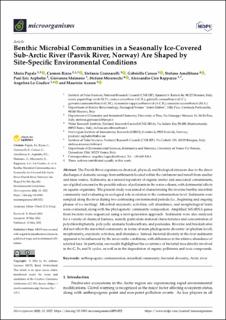| dc.contributor.author | Papale, Maria | |
| dc.contributor.author | Rizzo, Carmen | |
| dc.contributor.author | Giannarelli, Stefania | |
| dc.contributor.author | Caruso, Gabriella | |
| dc.contributor.author | Amalfitano, Stefano | |
| dc.contributor.author | Aspholm, Paul Eric | |
| dc.contributor.author | Maimone, Giovanna | |
| dc.contributor.author | Miserocchi, Stefano | |
| dc.contributor.author | Rappazzo, Alessandro Ciro | |
| dc.contributor.author | Lo Giudice, Angelina | |
| dc.contributor.author | Azzaro, Maurizio | |
| dc.date.accessioned | 2022-11-22T17:24:34Z | |
| dc.date.available | 2022-11-22T17:24:34Z | |
| dc.date.created | 2022-09-30T09:57:52Z | |
| dc.date.issued | 2022-05-12 | |
| dc.identifier.citation | Microorganisms. 2022, 10 (5), 1-26. | en_US |
| dc.identifier.issn | 2076-2607 | |
| dc.identifier.uri | https://hdl.handle.net/11250/3033484 | |
| dc.description.abstract | The Pasvik River experiences chemical, physical, and biological stressors due to the direct discharges of domestic sewage from settlements located within the catchment and runoff from smelter and mine wastes. Sediments, as a natural repository of organic matter and associated contaminants, are of global concern for the possible release of pollutants in the water column, with detrimental effects on aquatic organisms. The present study was aimed at characterizing the riverine benthic microbial community and evaluating its ecological role in relation to the contamination level. Sediments were sampled along the river during two contrasting environmental periods (i.e., beginning and ongoing phases of ice melting). Microbial enzymatic activities, cell abundance, and morphological traits were evaluated, along with the phylogenetic community composition. Amplified 16S rRNA genes from bacteria were sequenced using a next-generation approach. Sediments were also analyzed for a variety of chemical features, namely particulate material characteristics and concentration of polychlorobiphenyls, polycyclic aromatic hydrocarbons, and pesticides. Riverine and brackish sites did not affect the microbial community in terms of main phylogenetic diversity (at phylum level), morphometry, enzymatic activities, and abundance. Instead, bacterial diversity in the river sediments appeared to be influenced by the micro-niche conditions, with differences in the relative abundance of selected taxa. In particular, our results highlighted the occurrence of bacterial taxa directly involved in the C, Fe, and N cycles, as well as in the degradation of organic pollutants and toxic compounds. | en_US |
| dc.description.abstract | Benthic Microbial Communities in a Seasonally Ice-Covered Sub-Arctic River (Pasvik River, Norway) Are Shaped by Site-Specific Environmental Conditions | en_US |
| dc.language.iso | eng | en_US |
| dc.publisher | MDPI | en_US |
| dc.rights | Navngivelse 4.0 Internasjonal | * |
| dc.rights.uri | http://creativecommons.org/licenses/by/4.0/deed.no | * |
| dc.title | Benthic Microbial Communities in a Seasonally Ice-Covered Sub-Arctic River (Pasvik River, Norway) Are Shaped by Site-Specific Environmental Conditions | en_US |
| dc.title.alternative | Benthic Microbial Communities in a Seasonally Ice-Covered Sub-Arctic River (Pasvik River, Norway) Are Shaped by Site-Specific Environmental Conditions | en_US |
| dc.type | Peer reviewed | en_US |
| dc.type | Journal article | en_US |
| dc.description.version | publishedVersion | en_US |
| dc.rights.holder | © 2022 by the authors | en_US |
| dc.source.pagenumber | 1-26 | en_US |
| dc.source.volume | 10 | en_US |
| dc.source.journal | Microorganisms | en_US |
| dc.source.issue | 5 | en_US |
| dc.identifier.doi | 10.3390/microorganisms10051022 | |
| dc.identifier.cristin | 2057037 | |
| dc.relation.project | EC/H2020/262693 | en_US |
| dc.source.articlenumber | 1022 | en_US |
| cristin.ispublished | true | |
| cristin.fulltext | original | |
| cristin.qualitycode | 1 | |

